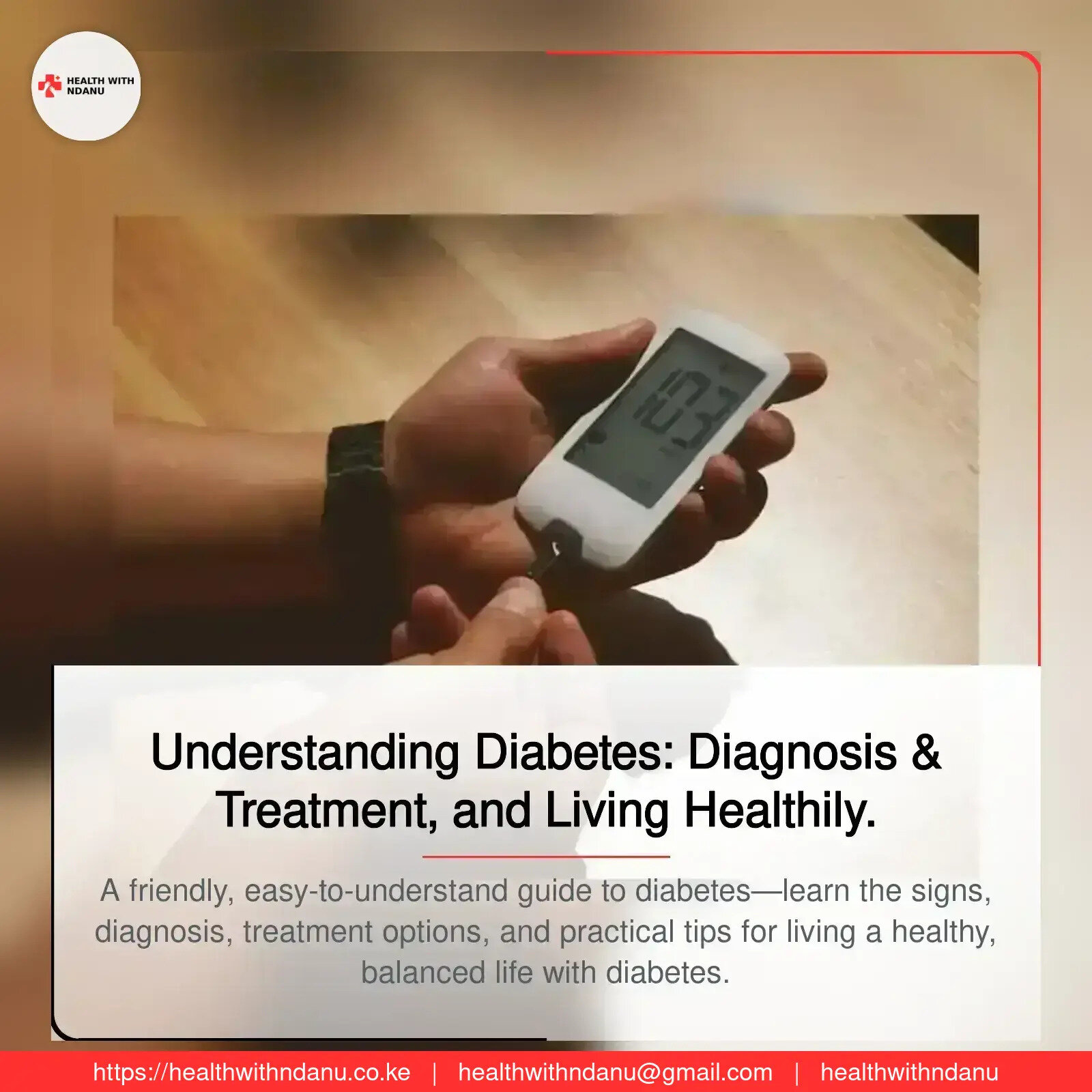Understanding Diabetes: Diagnosis & Treatment, and Living Healthily.



Introduction
Hi there! Let’s take a moment to dive into a topic that affects millions worldwide—diabetes. Whether you’re here because you’re curious, know someone with diabetes, or have been diagnosed, this guide will help you understand what diabetes is, how it’s diagnosed, its signs, treatment options, and, most importantly, how to live a healthy, fulfilling life with it.
So, grab a cup of tea (unsweetened, of course!) and let’s explore everything you need to know about diabetes.
What Is Diabetes?
At its core, diabetes is a condition where your body struggles to process glucose, a type of sugar that serves as your primary source of energy. To use glucose effectively, your body needs insulin, a hormone produced by the pancreas. In people with diabetes, insulin production or function is impaired, leading to high blood sugar levels.
Here’s a quick breakdown of the three main types of diabetes:
Type 1 Diabetes
This is an autoimmune condition where the body’s immune system attacks insulin-producing cells in the pancreas. People with Type 1 diabetes must rely on insulin therapy because their bodies no longer produce it. It’s commonly diagnosed in childhood or adolescence but can occur at any age.
Type 2 Diabetes
This is the most common type, often linked to lifestyle factors like diet, physical inactivity, and obesity. In Type 2 diabetes, the body doesn’t use insulin effectively (insulin resistance) and may not produce enough insulin. It typically develops in adults but is increasingly seen in children due to rising obesity rates.
Gestational Diabetes
This type develops during pregnancy when hormonal changes make the body less sensitive to insulin. It usually goes away after the baby is born, but it increases the mother’s risk of developing Type 2 diabetes later.
What Are the Signs of Diabetes?
Diabetes can develop silently, with symptoms often mistaken for other conditions. Knowing the warning signs can help with early diagnosis and better management.
Common Symptoms of Diabetes
1. Frequent thirst and urination: High blood sugar levels pull water from your tissues, making you thirsty and causing frequent trips to the bathroom.
2. Unexplained weight loss: When your body can’t use glucose for energy, it starts breaking down fat and muscle instead.
3. Extreme fatigue: Your body isn’t getting the energy it needs, leaving you constantly tired.
4. Blurred vision: High sugar levels can cause swelling in the lenses of your eyes.
5. Slow-healing wounds: High blood sugar can damage your nerves and blood vessels, impairing healing.
6. Tingling or numbness: This often occurs in the hands and feet due to nerve damage (diabetic neuropathy).
If you notice any of these symptoms, it’s essential to consult a healthcare provider.
How Is Diabetes Diagnosed?
Diagnosing diabetes involves straightforward medical tests to measure your blood sugar levels. Early detection is crucial for effective management, so don’t hesitate to reach out to a doctor if you’re experiencing symptoms.
Tests Used to Diagnose Diabetes
1. Fasting Blood Sugar Test
- Measures your blood sugar after at least 8 hours of fasting.
- A reading of 126 mg/dL or higher indicates diabetes.
2. A1C Test (Glycated Hemoglobin Test)
- Provides an average of your blood sugar levels over the past 2-3 months.
- A result of 6.5% or higher confirms diabetes.
3. Oral Glucose Tolerance Test (OGTT)
- Measures your blood sugar before and after drinking a sugary solution.
- A reading of 200 mg/dL or higher after 2 hours is a sign of diabetes.
4. Random Blood Sugar Test
- A random reading of 200 mg/dL or higher, along with symptoms, indicates diabetes.
- Once diagnosed, your doctor will determine the type of diabetes and recommend a treatment plan tailored to your needs.
How Is Diabetes Treated?
Managing diabetes requires a combination of medication, lifestyle changes, and regular monitoring. The treatment plan depends on the type of diabetes, but the goal is always the same: to keep your blood sugar levels within a healthy range.
Treating Type 1 Diabetes
- Insulin Therapy: Insulin is essential for people with Type 1 diabetes. It can be administered via injections or an insulin pump.
- Continuous Glucose Monitoring (CGM): A CGM device helps track blood sugar levels in real-time.
Treating Type 2 Diabetes
- Lifestyle Changes: Diet and exercise are the first lines of defense.
- Oral Medications: These help your body use insulin more effectively.
- Insulin: In some cases, people with Type 2 diabetes may require insulin.
Treating Gestational Diabetes
- Dietary Adjustments: Eating balanced meals helps manage blood sugar levels.
- Physical Activity: Regular exercise can improve insulin sensitivity.
- Monitoring: Blood sugar levels are closely monitored throughout pregnancy.
Living a Healthy Life with Diabetes
Diabetes management doesn’t stop with medication or treatment—it extends to daily habits and lifestyle choices. Here’s how you can thrive while living with diabetes:
1. Nutrition Matters
- Eating well is one of the most critical aspects of diabetes management.
- Focus on whole foods: Think veggies, lean proteins, whole grains, and healthy fats.
- Avoid sugary drinks and processed foods.
- Learn carbohydrate counting to manage blood sugar effectively.
2. Stay Active
- Regular exercise helps your body use insulin more efficiently and keeps your blood sugar levels stable.
- Aim for at least 150 minutes of moderate exercise per week.
- Activities like walking, swimming, and yoga are excellent options.
3. Monitor Your Blood Sugar
- Tracking your blood sugar helps you understand how food, activity, and medication affect your levels.
- Use a blood glucose monitor or continuous glucose monitor (CGM).
4. Manage Stress
- Stress can spike blood sugar levels, so finding ways to relax is essential.
- Practice meditation, deep breathing, or yoga.
- Engage in hobbies that bring you joy.
5. Stay Educated
The more you know about diabetes, the better you can manage it. Keep up with the latest research and attend diabetes education programs.
6. Build a Support Network
Living with diabetes can be challenging, but you don’t have to do it alone.
- Join diabetes support groups.
- Share your journey with family and friends—they can be your biggest cheerleaders.
Complications and Prevention
If unmanaged, diabetes can lead to serious complications such as heart disease, kidney damage, or vision problems. The good news? Staying proactive with your health can prevent or delay these issues.
Tips for Prevention
- Stick to your treatment plan.
- Attend regular check-ups with your healthcare team.
- Monitor blood pressure and cholesterol levels.
Final Thoughts
Living with diabetes might seem overwhelming at first, but with the right approach, it’s entirely manageable. From understanding the signs to embracing a healthy lifestyle, every step you take is a step toward better health and well-being.
Remember, you’re not alone. Millions of people worldwide are living vibrant lives with diabetes, and so can you!
Let’s keep the conversation going—what’s one thing you learned today about diabetes? Share your thoughts in the comments, and let’s inspire each other to lead healthier lives.
Una uzoefu wako? Shiriki nasi
Kategoria Maarufu
Blogu Zinazotembelewa Zaidi
Daily Newsletter
Get all the top stories from Blogs to keep track.



